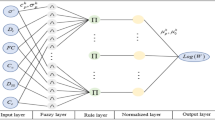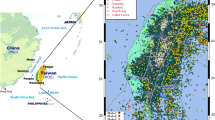Abstract
This study presents two optimization techniques: genetic algorithm (GA) and particle swarm optimization (PSO), to improve the efficiency of backpropagation (BP) neural network model for predicting liquefaction susceptibility of soil. A detailed parametric study is designed and performed to find the optimal parameters of GA and PSO, respectively. The database used in this study includes 166 CPT-based field observations from more than eight major earthquakes between 1964 and 1983. Six factors including cone resistance, total vertical stress, effective vertical stress, depth of penetration, normalized peak horizontal acceleration at ground surface and earthquake magnitude are selected as the evaluating indices. The predictions from the PSO–BP model were compared with those from two models: BP and GA–BP. The study concluded that the proposed PSO–BP model improves the classification accuracy and is a feasible method in predicting soil liquefaction.










Similar content being viewed by others
References
Alemdag S, Gurocak Z, Cevik A, Cabalar AF, Gokceoglu C (2016) Modeling deformation modulus of a stratified sedimentary rock mass using neural network, fuzzy inference and genetic programming. Eng Geol 203:70–82
Banerjee TP, Das S (2012) Multi-sensor data fusion using support vector machine for motor fault detection. Inf Sci 217:96–107
Belkhatir M, Schanz T, Arab A, Della N, Kadri A (2014) Insight into the effects of gradation on the pore pressure generation of sand–silt mixtures. Geotech Test J 37(5):922–931
Cabalar AF, Cevik A (2009) Genetic programming-based attenuation relationship: an application of recent earthquakes in turkey. Comput Geosci 35(9):1884–1896
Cabalar AF, Cevik A (2011) Triaxial behavior of sand–mica mixtures using genetic programming. Expert Syst Appl 38(8):10358–10367
Cabalar AF, Cevik A, Guzelbey IH (2010) Constitutive modeling of Leighton Buzzard sands using genetic programming. Neural Comput Appl 19(5):657–665
Cevik A, Cabalar AF (2009) Modelling damping ratio and shear modulus of sand-mica mixtures using genetic programming. Expert Syst Appl 36(4):7749–7757
Chern SG, Lee CY (2009) CPT-based simplified liquefaction assessment by using fuzzy-neural network. J Mar Sci Technol 17(4):326–331
Chern SG, Lee CY, Wang CC (2008) CPT-based liquefaction assessment by using fuzzy-neural network. J Mar Sci Technol 16(2):139–148
Ding SF, Su CY, Yu JZ (2011) An optimizing BP neural network algorithm based on genetic algorithm. Artif Intell Rev 36(2):153–162
Erzin Y, Ecemis N (2015) The use of neural networks for CPT-based liquefaction screening. Bull Eng Geol Environ 74(1):103–116
Farrokhzad F, Choobbasti AJ, Barari A (2012) Liquefaction microzonation of Babol city using artificial neural network. J King Saud Univ Sci 24(1):89–100
Ghosh S, Das S, Kundu D, Suresh K, Panigrahi BK, Cui ZH (2012) An inertia-adaptive particle swarm system with particle mobility factor for improved global optimization. Neural Comput Appl 21(2):237–250
Goh ATC (1994) Seismic liquefaction potential assessed by neural networks. J Geotech Eng 120(9):1467–1480
Goh ATC (1996) Neural network modeling of CPT seismic liquefaction data. J Geotech Eng 122(1):70–73
Goh ATC (2002) Probabilistic neural network for evaluating seismic liquefaction potential. Can Geotech J 39:219–232
Guettaya I, El Ouni MR (2014) In situ-based assessment of soil liquefaction potential-case study of an earth dam in Tunisia. Front Struct Civ Eng 8(4):456–461
Jha SK, Suzuki K (2009) Reliability analysis of soil liquefaction based on standard penetration test. Comput Geotech 36(4):589–596
Juang CH, Chen CJ, Jiang T, Andrus RD (2000) Risk-based liquefaction potential evaluation using standard penetration tests. Can Geotech J 37(6):1195–1208
Juang CH, Yuan HM, Lee DH, Lin PS (2003) Simplified cone penetration test-based method for evaluating liquefaction resistance of soils. J Geotech Geoenviron Eng 129(1):66–80
Karegowda AG, Manjunath AS, Jayaram MA (2011) Application of genetic algorithm optimized neural network connection weights for medical diagnosis of Pima Indians diabetes. Int J Soft Comput 2(2):15–22
Karthikeyan J, Kim D, Aiyer BG, Samui P (2013) SPT-based liquefaction potential assessment by relevance vector machine approach. Eur J Environ Civ Eng 17(4):248–262
Kennedy J, Eberhart RC (1995) Particle swarm optimization. In: Proceedings of the 1995 IEEE international conference on neural networks, vol 4, Perth, Australia. IEEE Service Center, Piscataway, pp 1942–1948
Kumar S, Naresh R (2007) Efficient real coded genetic algorithm to solve the non-convex hydrothermal scheduling problem. Int J Electr Power Energy Syst 29(10):738–747
Kurup PU, Dudani NK (2002) Neural networks for profiling stress history of clays from PCPT data. J Geotech Geoenviron 128(4):569–579
Lee CY, Chern SG (2013) Application of a support vector machine for liquefaction assessment. J Mar Sci Technol 21(3):318–324
Marcuson WF III (1978) Definition of terms related to liquefaction. J Geotech Eng Div ASCE 104(9):1197–1200
Mughieda O, Bani HK, Safieh B (2009) Liquefaction assessment by artificial neural networks based on CPT. Int J Geotech Eng 2:289–302
Nasir M, Das S, Maity D, Sengupta S, Halder U, Suganthan PN (2012) A dynamic neighborhood learning based particle swarm optimizer for global numerical optimization. Inf Sci 209:16–36
Padmini D, Ilamparuthi K, Sudheer KP (2008) Ultimate bearing capacity prediction of shallow foundations on cohesionless soils using neurofuzzy models. Comput Geotech 35:33–46
Pal M (2006) Support vector machines-based modeling of seismic liquefaction potential. Int J Numer Anal Methods 30(10):983–996
Pour MN, Asakereh A (2015) A comparison between two field methods of evaluation of liquefaction potential in the Bandar Abbas city. Am J Civ Eng 3(2–2):1–5
Ramakrishnan D, Singh TN, Purwar N, Badre KS, Gulati A, Gupta S (2008) Artificial neural network and liquefaction susceptibility assessment: a case study using the 2001 Bhuj earthquake data, Gujarat, India. Comput Geosci 12:491–501
Ren Z, San Z (2007) Improvement of real-valued genetic algorithm and performance study. Acta Electron Sin 35(2):269–274
Ren C, An N, Wang JZ, Li L, Hu B, Shang D (2014) Optimal parameters selection for BP neural network based on particle swarm optimization: a case study of wind speed forecasting. Knowl Based Syst 56:226–239
Sakthivel VP, Bhuvaneswari R, Subramanian S (2010) An improved particle swarm optimization for induction motor parameter determination. Int J Comput Appl 1(2):62–67
Samui P (2007) Seismic liquefaction potential assessment by using relevance vector machine. Earthq Eng Eng Vib 6(4):331–336
Samui P (2013) Liquefaction prediction using support vector machine model based on cone penetration data. Front Struct Civ Eng 7(1):72–82
Samui P, Sitharam TG (2011) Machine learning modelling for predicting soil liquefaction susceptibility. Nat Hazards Earth Syst Sci 11:1–9
Tang Y, Zang YQ, Huang G, Hu X (2005) Granular SVM-RFE gene selection algorithm for reliable prostate cancer classification on microarray expression data. In: Proceedings of the 5th IEEE symposium on bioinformatics and bioengineering (BIBE’05)
Whitley D, Starkweather T, Bogart C (1990) Genetic algorithms and neural networks: optimizing connection and connectivity. Parallel Comput 14(3):347–361
Xue XH, Yang XG (2014) Seismic liquefaction potential assessed by fuzzy comprehensive evaluation method. Nat Hazards 71:2101–2112
Yamagami Y, Jiang JC (1997) A search for the critical slip surface in three-dimensional slope stability analysis. Soils Found 37(3):1–16
Young-Su K, Byung-Tak K (2006) Use of artificial neural networks in the prediction of liquefaction resistance of sands. J Geotech Geoenviron Eng 132(11):1502–1504
Zhang G, Robertson PK, Brachman RWI (2004) Estimating liquefaction-induced lateral displacements using the standard penetration test or cone penetration test. J Geotech Geoenviron Eng 130(8):861–871
Zhao WG (2012) BP neural network based on PSO algorithm for temperature characteristics of gas nanosensor. J Comput 7(9):2318–2323
Acknowledgements
This work was supported by CAS Pioneer Hundred Talents Program.
Author information
Authors and Affiliations
Corresponding author
Rights and permissions
About this article
Cite this article
Xue, X., Liu, E. Seismic liquefaction potential assessed by neural networks. Environ Earth Sci 76, 192 (2017). https://doi.org/10.1007/s12665-017-6523-y
Received:
Accepted:
Published:
DOI: https://doi.org/10.1007/s12665-017-6523-y




